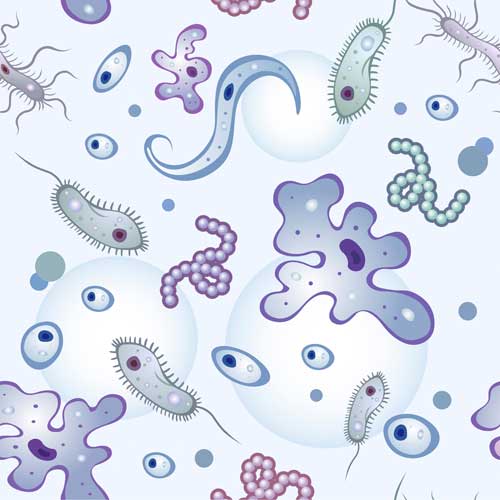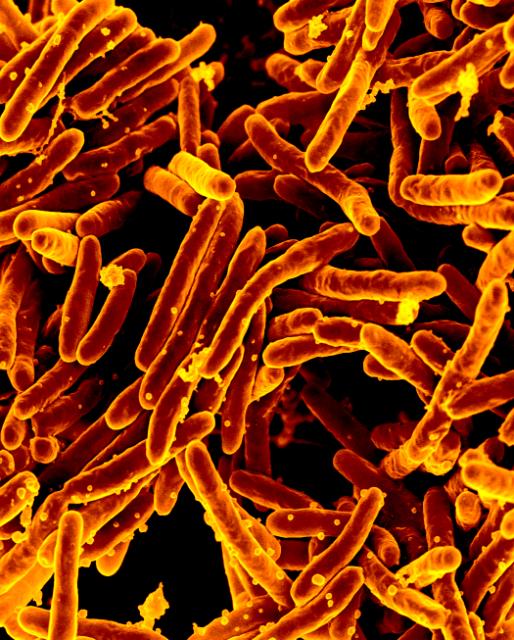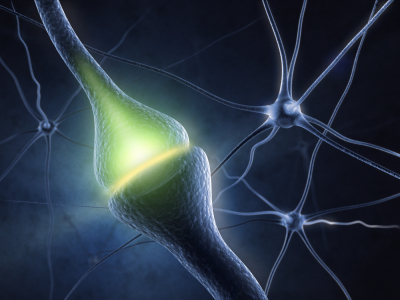Smallpox was a disease caused by infection with one of two strains of Variola virus (Variola major and Variola minor) and a worldwide scourge that killed up 35% of the people it infected. Luckily, a vaccine was developed when Edward Jenner noticed milkmaids infected with cowpox did not contract smallpox. While Jenner was not the first to vaccinate against smallpox, his discovery and testing were spread to a wide audience and thus became the basis for the vaccination efforts that have eradicated the virus in our lifetime. Despite all the research on smallpox, not much is known about the evolution of the virus. Sequence data for the virus only span the last 50–60 years. However, recent efforts published in the New England Journal of Medicine uncovered a new source for examining the history of smallpox infection: mummies.
Continue reading “Mummies are a Reservoir of Viral History”Microorganisms: Infectious Disease and Ecology
Blog entries about bacteria, viruses, fungi and other microorganisms.
My Microbiome Made Me Do It

When I was in school I learned that there were two different kinds of bacteria, the nasty ones (pathogens) that could make you sick and the nice ones (commensals), which simply colonized you and did nothing much except occupy a spot that could otherwise be taken up by a pathogen. Any role for those commensal bacteria in health and disease was assumed to be no more than that of a harmless squatter. In recent years, studies of this benign microbial population (microbiome studies) have begun to reveal many more intriguing details about how they affect our health and wellbeing. Maybe it’s not so surprising that “good” bacteria could be good for our health—but could they actually affect how we behave? A review in Science summarized findings that indicate that this is indeed the case—at least for certain animal populations. Could it be true for humans as well? Could our colonizing organisms actually influence how we feel and what we do?
Continue reading “My Microbiome Made Me Do It”The Healing Power of Yogurt
There has been much made of probiotics regulating digestive health in the news and repeatedly hawked by people sharing the benefits of yogurt with special bacteria that will change your life. I was advised by my mother that when I was taking antibiotics, eating yogurt would help counteract some of the negative consequences of oral antibiotics and repopulate my gastrointestinal tract with beneficial bacteria. But I was unaware of research published in Bioscience, Biotechnology, and Biochemistry showing that yogurt with Lactobacillus gasseri could actually heal acid-induced ulcers—at least in rats. Continue reading “The Healing Power of Yogurt”
Cancer research yields unexpected results
 Louis Pasteur once said “Chance favors the prepared mind”. Surely any scientist can attest to this. Discoveries of things like artificial sweeteners, Teflon, and penicillin were all unintended products of unrelated research. Recently, scientists at the Duke Cancer Institute studying the microevolution of enzymes involved in cancer happened upon a missing enzymatic link in a very unrelated area of research that has less to do with cancer than with the production of carpeting, apparel, and auto parts(1).
Louis Pasteur once said “Chance favors the prepared mind”. Surely any scientist can attest to this. Discoveries of things like artificial sweeteners, Teflon, and penicillin were all unintended products of unrelated research. Recently, scientists at the Duke Cancer Institute studying the microevolution of enzymes involved in cancer happened upon a missing enzymatic link in a very unrelated area of research that has less to do with cancer than with the production of carpeting, apparel, and auto parts(1).
Nylon is a critical component in all of those products, any many, many more. Production nylon requires a compound called adipic acid. This intermediary, one of the most widely used chemicals in the world, is produced from fossil fuels and pollution released from its refinement process is a leading contributor to global warming. To date, there hasn’t been a “green” way of producing adipic acid because there is one critical enzyme in the synthesis pathway that isn’t available: 2-hydroxyadipate dehydrogenase.
Biochemical engineering on its own had not produced a sufficient dehydrogenase to do the job. Enter the cancer researchers. Cancer involves the microevolution of cells which offer benefits to the cells, sometimes including gain-of-function mutations in metabolic enzymes. Duke researchers identified a mutation in glioblastomas that alters the function of isocitrate dehydrogenase. The Duke team applied their knowledge of how enzymes change during cancer to lay the blueprints on a new method for producing clean, green, adipic acid. By using the same mutation framework, the scientist found that they could create enzymes from homoisocitrate dehydrogenase found in yeasts and bacteria that were capable of producing adipic acid from inexpensive sugars. The group still needs to scale up their production, a process that will still require a tremendous amount of work.
1. Reitman, Z. et al. (2012) Enzyme redesign guided by cancer-derived IDH1 mutations. Nat. Chem. Biol. Available online.
Happy Birthday to You: Are Your Hands Clean?
 My daughter has been actively planning her birthday for about three weeks now (and she still has almost two months to wait). At the top of her wish list this year? Hand sanitizer. As my kids headed back to school this week, I noticed that one of the most popular pieces of backpack “bling” among her little friends was little bottles of: you guessed it, hand sanitizer. In bright colored silicone covers, with yummy sounding scents, little bottles of hand sanitizer bounced along on the backpacks of a lot of the youngsters walking into the school.
My daughter has been actively planning her birthday for about three weeks now (and she still has almost two months to wait). At the top of her wish list this year? Hand sanitizer. As my kids headed back to school this week, I noticed that one of the most popular pieces of backpack “bling” among her little friends was little bottles of: you guessed it, hand sanitizer. In bright colored silicone covers, with yummy sounding scents, little bottles of hand sanitizer bounced along on the backpacks of a lot of the youngsters walking into the school.
The first thought that might come into your head is “Wow. Those kids are going to be so healthy. All those nasty germs might as well look elsewhere for victims.” And you would be at least partially right. Proper hand hygiene can decrease the transmission of cold viruses as well as other germs, and hand sanitizer can play a part in good hand hygiene when it is used properly and in the right quantity.
What hand sanitizer can not do is take the place of washing hands. It does not, for instance, remove dirt or other contaminants. (Although it can help smear the dirt around so that it forms a more evenly dispersed layer, prompting your child to claim their hands have been cleaned). Hand sanitizers also will not effectively eliminate nonenveloped viruses such as the norovirus. These are the nasty little things that are responsible for the majority of acute gastrointestinal illnesses. (1,2,3). In fact, using hand sanitizers may actually increase the spread of these viruses if it results in a decrease of hand washing with soap and water.
Hand sanitizers that are most effective contain ethyl alcohol (62% to 95% concentration), benzalkonium chloride, salicylic acid, pyroglutamic acid, and triclosan. These ingredients, while making the sanitizers effective against some germs, also dry out the skin and destroy some to the naturally existing fauna on the skin, which gives other germs a chance to take hold. An example is Clostridium difficile. This gram-positive, spore-forming bacteria can cause severe intestinal upset and diarrhea when competing bacteria in the digestive track have been wiped out by antibiotics. A 2010 study found that some people who were over reliant on sanitizers had C. difficile spores colonizing on their hands (4).
C. difficile infections are probably not a big risk for the average school-age child, but the example highlights the fact that hand sanitizers are not the silver bullet of hand hygiene that they are sometimes portrayed to be. The center for Disease Control and Prevention (CDC) in the U.S. lists the following guidelines for hand washing:
- Wet your hands with clean running water (warm or cold) and apply soap.
- Rub your hands together to make a lather and scrub them well; be sure to scrub the backs of your hands, between your fingers, and under your nails.
- Continue rubbing your hands for at least 20 seconds. Need a timer? Hum the “Happy Birthday” song from beginning to end twice.
- Rinse your hands well under running water.
- Dry your hands using a clean towel or air dry.
Washing hands with soap and water is the best way to reduce the number of germs on them. If soap and water are not available, use an alcohol-based hand sanitizer that contains at least 60% alcohol. Alcohol-based hand sanitizers can quickly reduce the number of germs on hands in some situations, but sanitizers do not eliminate all types of germs. (5).
My daughter’s birthday is still two months away, but I am going to suggest to her that she start practicing for it now. I am going to suggest she sing “Happy Birthday” to herself twice while washing her hands, and leave the hand sanitizer on her backpack for those times when soap and water are not available.
References
- Liu P, Yuen Y, Hsiao HM, Jaykus LA, Moe C. (2010) Appl Environ Microbiol. 76, :394–9.
- Hand sanitizers may actually cause outbreaks of norovirus. Medical New Today website. ww.medicalnewstoday.com/articles/232708.php. Accessed August 29, 2012.
- Hall AJ, Vinjé J, Lopman B, et al. Updated norovirus outbreak management and disease prevention guidelines. Centers for Disease Control and Prevention website. www.cdc.gov/mmwr/preview/mmwrhtml/rr6003a1.htm. Accessed August 29, 2012.
- Jabbar, U., Leischner, J., Kasper, D., et al. (2010) Infect Control Hosp Epidemiol. 31, 56–70.
- CDC website http://www.cdc.gov/features/handwashing/ Accessed August 29, 2012.
Protein Profiling of a Lung Infection in a 500-Year-Old Mummy
 I am fascinated by all the ways that scientists are taking sensitive techniques and using them to look into our past. For example, scientists constructed the entire genome of Yersinia pestis, the caustive agent of the Black Death, from teeth and bone samples of plague victims from the 14th century. Without methods like polymerase chain reaction (PCR), such an analysis could not be performed. My fellow blogger Terri discussed how a postmortem autopsy of Ozti, a mummy found in the Alps, used modern techniques to learn not only what color his eyes were but that he suffered from Lyme disease. In a recent PLOS ONE article, Corthals et al. took this analysis of preserved human remains further to determine if a mummy from the Andes in Argentina may have suffered from an active lung infection, testing for an immune response by protein profiling. Continue reading “Protein Profiling of a Lung Infection in a 500-Year-Old Mummy”
I am fascinated by all the ways that scientists are taking sensitive techniques and using them to look into our past. For example, scientists constructed the entire genome of Yersinia pestis, the caustive agent of the Black Death, from teeth and bone samples of plague victims from the 14th century. Without methods like polymerase chain reaction (PCR), such an analysis could not be performed. My fellow blogger Terri discussed how a postmortem autopsy of Ozti, a mummy found in the Alps, used modern techniques to learn not only what color his eyes were but that he suffered from Lyme disease. In a recent PLOS ONE article, Corthals et al. took this analysis of preserved human remains further to determine if a mummy from the Andes in Argentina may have suffered from an active lung infection, testing for an immune response by protein profiling. Continue reading “Protein Profiling of a Lung Infection in a 500-Year-Old Mummy”
Tracking the Progression of Plague Using Bioluminescence
 Sequencing Yersinia pestis, the bacterium that caused the Black Plague in Europe during 1348–50, is an amazing accomplishment. Y. pestis infection still occurs sporatically and causes fatalities despite the Age of Antibiotics. Even with animal models, there are questions remaining about the progression of infection. Nham et al. used in vivo imaging to examine the course of infection in a mouse animal model using a bioluminescent clone of Y. pestis. Continue reading “Tracking the Progression of Plague Using Bioluminescence”
Sequencing Yersinia pestis, the bacterium that caused the Black Plague in Europe during 1348–50, is an amazing accomplishment. Y. pestis infection still occurs sporatically and causes fatalities despite the Age of Antibiotics. Even with animal models, there are questions remaining about the progression of infection. Nham et al. used in vivo imaging to examine the course of infection in a mouse animal model using a bioluminescent clone of Y. pestis. Continue reading “Tracking the Progression of Plague Using Bioluminescence”
Targeted Medicine: Using Bacteria as Navigators

[Yawn] Another bacterial strain in a world where bacteria are one of the most abundant life forms. Ho hum, right? Not so fast! Wait until you see what these bacteria—or more specifically, the magnetosomes—can do. Magnetotactic bacteria might provide us with a great new tool to target delivery of chemotherapeutic drugs, recombinant proteins and medically relevant antibodies, ligands and nucleic acids to treat a wide range of diseases. Continue reading “Targeted Medicine: Using Bacteria as Navigators”
Fungi, a Tool for Weed Control?
While I enjoy growing a variety of produce from tomatoes, basil and garlic to blueberries, one thing remains the bane of my existence: weeds. My least favorite: quackgrass. I even dug up an entire garden bed to rid myself of the weed and its long rhizomes. How well do you think that worked? I found that the quackgrass happily grew around the popcorn I planted in that same location. What is a gardener to do? Well, recent research by Veiga et al. demonstrates that fungus can lend a helping hand and suppress growth of some weed species. Continue reading “Fungi, a Tool for Weed Control?”
Seeing the Potential
 I had never heard of Halorubrum sodomense until a few days ago. It’s name describes it pretty well, it is a salt-tolerant (Halophilic) organism that contains the red-colored photosynthetic pigment archaerhodopsin, and it was originally isolated from the region of Sodom near the Dead Sea. It’s an organism that is well-known only to those with reason to study it. Many of the rest of us will never have cause to say its name, or to even remember it, and may even occasionally wonder why it is studied at all.
I had never heard of Halorubrum sodomense until a few days ago. It’s name describes it pretty well, it is a salt-tolerant (Halophilic) organism that contains the red-colored photosynthetic pigment archaerhodopsin, and it was originally isolated from the region of Sodom near the Dead Sea. It’s an organism that is well-known only to those with reason to study it. Many of the rest of us will never have cause to say its name, or to even remember it, and may even occasionally wonder why it is studied at all.
Halorubrum sodomense was in the news recently because a genetically engineered form of its rhodopsin was used to create a method that lights up mammalian neurons as they fire. This exciting development was reported in a paper by Kralj et al, published in the Nov 27 issue of Nature Methods. Continue reading “Seeing the Potential”
